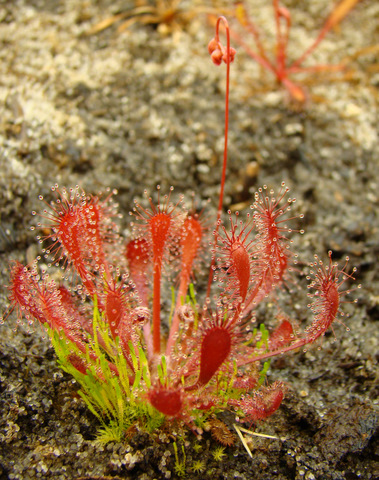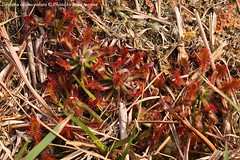Drosera oblanceolata
Drosera oblanceolata originates from the subtropical climate of Sunset Peak in Hong Kong. It can develop stunning red coloration when given enough light. This striking sundew is becoming a bit more common in cultivation in recent times, but is still fairly difficult to obtain. When provided higher humidity, D. oblanceolata is among the easiest sundews to grow (on the tray method, at least). However, it can not tolerate warmer temperatures very well, unless additional humidity is supplied.
Media: 1 peat: 1 sand is the mix my plants are growing in at the
moment. Living sphagnum or good-quality dead sphagnum has worked very nicely as well
in the past. Not picky. See habitat info below
for a picture of the native soil D.
oblanceolata can be found growing in.
Media moisture: Drosera oblanceolata seems to do best in moist to very moist/damp soils. It
can grow well in a bit drier soils if temperatures are cooler.
Pot height: grows well in 3-4 inch pots or even a bit smaller when
younger. Larger pots (6-8 inches tall) don’t seem to increase the plant’s size much,
if at all.
Humidity: in hot temperatures of 800+F (270C+) (indoors on the tray method), Drosera oblanceolata prefers higher humidity (50%-60%+). Otherwise, the plant tends to produce leaves without dew or tentacles (see picture below). Based on the results from another grower and personal experience, this species appreciates higher humidity at any temperature (but it is not required in cooler temperatures).
Trapping and speed: average. Noticeable tentacle movement within a couple hours.
Leaves will also curl over food (see picture above/left).
Feeding: dramatically speeds up growth (especially when growing from seed
or propagating this species). If not fed, D.
oblanceolata will grow fairly slowly and will produce very few flowers. See feeding page for
more information.
Food size: small to medium.
Plant dimensions and structure: the leaves of Drosera
oblanceolata can reach a height of 2 inches from the base of the petiole
to the tip of the leaf. The plant may only stay about a half inch smaller, upon
reaching maturity, if left unfed.
This species produces white hairs on the petioles, especially when
under bright light intensity. The petiole margins and backside of the
petiole contain the most hairs (see above right picture). Feel free to check out the youtube video I made
of D. oblanceolata here in order to get a better idea of this plant's size (muting the audio is encouraged ;)).
Light Intensity & Photoperiod: Give as
much light as possible. Tentacles and leaves will become a vibrant red color in
bright light (or if fed infrequently).
Temperature: Drosera
oblanceolata thrives in cool to warm temperatures (50-75F) when grown indoors on the tray
method but seems to only thrive in hot conditions (~85F) if provided with elevated
humidity. On the tray method, indoors, this species has survived for me through temps of
85-90F (30C) without additional humidity provided. But this is not recommended
if you want your plant to be as healthy as possible (see pics directly below). I
essentially neglect my plants every summer and I’m fortunate enough that this
species is willing to hang on and survive my abuse :). See habitat
info below for the natural temperatures of Sunset Peak, Hong Kong.
Dormancy requirements: no dormancy required, but goes into a dormancy-like "survival mode" when subjected to a combination of high temps and low humidity (pictures above). During this pattern of growth, the tentacle portion of the leaf will not develop, and frequently turns brown or shrivels up. No dew is produced, consequentially. The leaves also become smaller during this time. Provide additional humidity to avoid this occurrence. Can be grown year-round indoors (or outdoors in warm enough climates).
Flowers and Seeds: Self-fertile. When fed often after
reaching maturity, Drosera oblanceolata
will produce an abundance of large seeds. The flowers on my plant are a pinkish-peach color (see picture below), but in nature, there are other
white-flowered varieties. You can expect this species to flower within ~1.5 years when grown to maturity from seed,
(if fed moderately).
Genetics: 2n=40.
Several interesting hybrids have been made, including crosses of D. oblanceolata with a variety of
different species, such as D.
capillaris (n=20), D. neocaledonica
(n=40), and D. spatulata. The
naturally occurring hybrid of Drosera
oblanceolata with D. spatulata is
known as D. sp. “Lantau Island Hybrid.” The "Launtau Island Hybrid" can handle hot temperatures quite easily.
Where can I obtain this sundew? I purchased my original
plant in 2009 from Cook’s Carnivores. I have only seen it sold there
infrequently. Seeds and plants can also be found at bestcarnivorousplants.net.
Otherwise, keep your eye out for occasional trades, sales and giveaways at
terraforums.com and cpukforum.com. If you're in Canada, check out keehnscarnivores.com, since they have this species available for sale.
Propagation Techniques
For detailed
instructions, visit the sundew propagation page.
Seed: easy-
no cold stratification required. Give seeds a warm, moist,
humid environment for highest germination rates. Follow the guidelines on this page in
order to speed up the growth of your seedlings.
Leaf-cuttings: work very well (plants in below left and above right pictures are ~6 months old from leaf cuttings). Warmer temperatures stimulate better strike rates. Make sure to feed the plantlets after they sprout in order to rapidly speed up growth.
Root
cuttings: Roots
are fairly slender, so try using the largest roots available for the
best results. Take root cuttings during the coolest part of the year to
avoid stressing the plant.
Flower
stalk cuttings: I haven't tried this yet, since it doesn’t seem that it would
work very well with this type of more slender flower stalk.
Base stem cuttings (Stem cutting at base of stem): works
quite well (see above right pic). I generally clip the stem slightly
below the soil surface. Then,
place the upper half of the plant in a clear sealed container with some
moist dead
or living sphagnum moss. I place the container very close to the
fluorescent lights in my T-8 fixture, but a
well-lit windowsill will work just as well, as long as the sealed
container
doesn’t overheat. In a month or so, you will be able to see roots
developing--- carefully peel back the sphagnum moss from the base of
the stem to monitor their progress. After a
few months of regular feeding, the plant should be established and can
be
potted up normally on the tray method (after acclimation, if needed).
Meanwhile, in the pot that you originally took the base stem cuttings,
you
should observe plantlets emerging from the roots where the original
plants were
taken from. These will grow very quickly into mature plants, especially
when
fed. Click here
for a stem cutting guide, made for D.
madagascariensis (similar concepts).
Divisions: Be careful not to break
or disturb the somewhat slender roots that branch out through the soil. If the roots
are kept intact, this plant will have no trouble handling divisions- I usually
don’t supplement additional humidity after transplanting, unless temperatures
are above 75-800+F (~260C). This plant can spread more
readily on its own in a consistently moist living sphagnum mix.
Habitat Information
Drosera oblanceolata is native to the subtropical climate of Sunset Peak, in Hong Kong. The temperatures on Sunset Peak,
during the warmest part of the year, can reach 82 degrees F
(~28C). It is quite humid during these warmer months (from May to
September). During
the winter, temperatures generally never drop below freezing and
generally remain around 50 degrees F (10 degrees C). This species can
be found growing in sunny meadows and bogs.
As can be seen in the pictures below, the soil appears to be
peat-based, or simply nutrient poor soil. More info to come in the near
future...Habitat Photos- used with permisson from kuno menjina


Additional Questions or Suggestions?
Contact me at: sundewman(at)yahoo.com